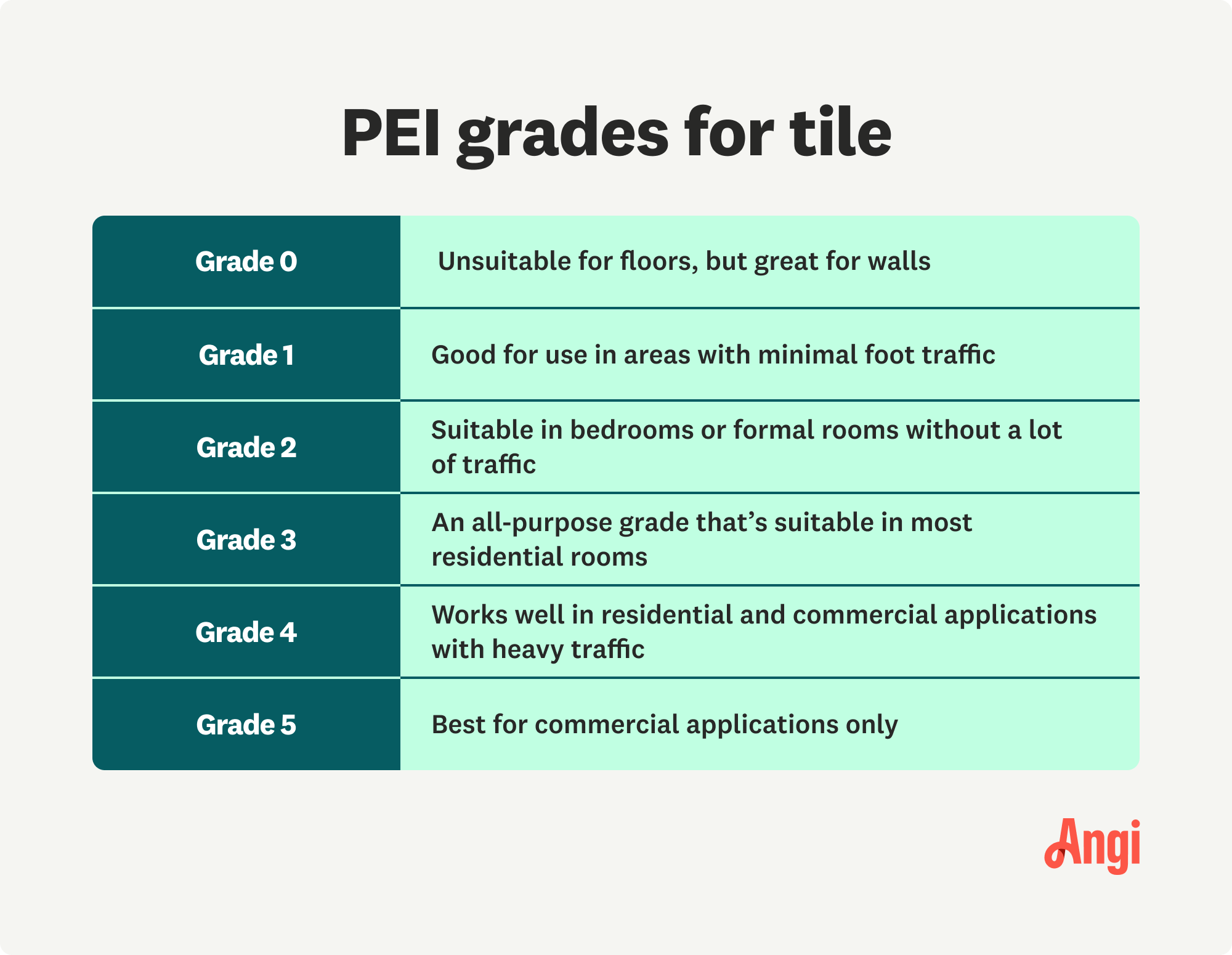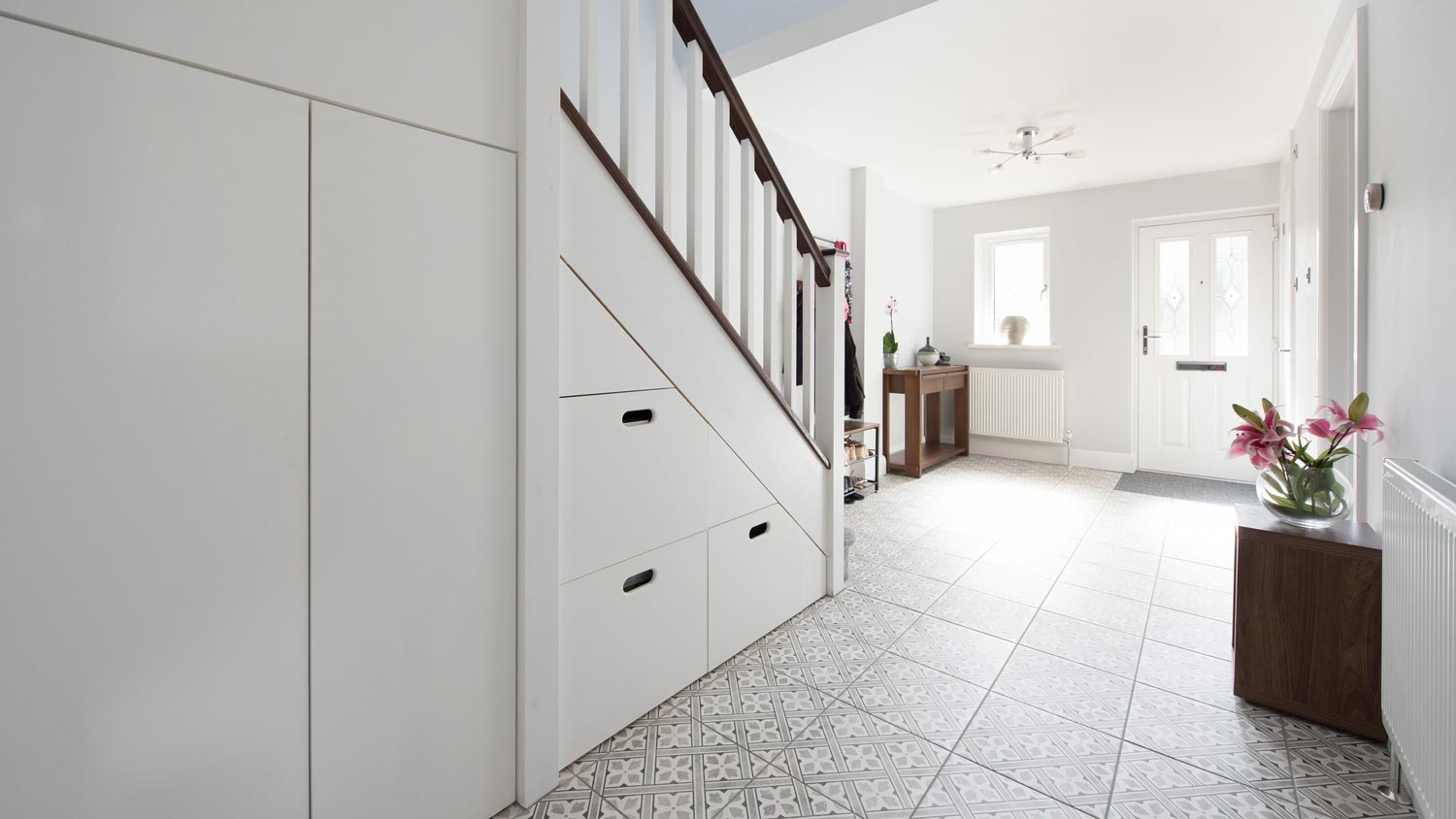What Is a PEI Rating? Uncovering the Secret to Choosing the Best Tile for Your Next Project
Knowing a tile’s PEI rating helps you choose the best tile for the job


PEI rating determines a tile’s durability.
Tiles are rated on a scale of 0 to 5, with 5 being the toughest.
Each room does better with different tile ratings, with high-traffic areas requiring a grade of 3 or higher.
Higher PEI-rated tiles typically cost more than lower-rated tiles.
Shopping for new tile is exciting, but choosing the best tile for the area depends on many factors. First, you should ask what is the PEI rating? Knowing the answer to this question will narrow your options and ensure the tile you choose will withstand the room’s traffic and use.
What Is PEI Rating?
When installing new tile, it's essential to understand its durability—and luckily, PEI rating provides a helpful scale for doing so.
A PEI rating, which ranges from 1 to 5, shows a tile's resistance to abrasion according to the PEI Institute's standards, which use machines to mimic different traffic levels and assign a PEI rating. The more abrasion tile can handle, the better suited it is for high-traffic areas, thus, the higher the rating. It's important to note the PEI rating measures a tile's hardness and durability based on its surface layer.
For example, there's a significant difference between installing tile on a shower wall versus the kitchen floor. A kitchen floor gets much more traffic and must be able to withstand more abrasion, or it will wear out faster.
When choosing the best tile for a bathroom floor or kitchen tile, the PEI rating should be one of the top factors you consider.
How PEI Ratings Are Determined
The Porcelain Enamel Institute provides PEI ratings throughout the industry, acting as a clearinghouse between consumers and manufacturers. They aren't authoritarian figures but provide informational ratings to help you choose the right tile for your space.
The PEI uses a rotary abrasion machine that mimics foot traffic and abrasion on porcelain and ceramic tiles. The machine tallies the number of revolutions the tile can withstand before showing abrasion, with the total number of revolutions determining the tile’s PEI rating.
PEI Ratings Broken Down

The point of tiling PEI rating is to determine when a tile's appearance begins to deteriorate, helping consumers and contractors choose the best tiling for the area.
Whether you're looking at kitchen or bathroom tile trends, considering the tile’s PEI rating is essential to long-lasting tile.
Grade 0
Tile with a PEI rating of 0 is only suitable for walls, such as shower surrounds. It cannot withstand foot traffic and shouldn't be used on floors. If you mistakenly use this tile in high-traffic areas, you'll need to learn how to regrout tile floors and possibly replace it often.
Grade 1
Tile with a Grade 1 PEI rating is suitable for flooring only in areas with very little traffic. Like tile with a PEI rating of Grade 0, it's best for shower walls or kitchen backsplashes. If used in areas with foot traffic, it should only be in areas with minimal traffic without shoes, such as a bedroom floor.
Grade 2
As we move up the rating scale, the abrasion resistance of the tile increases. A PEI rating of Grade 2 is best for areas with light traffic, such as bathrooms, bedrooms, or formal rooms that don't receive much traffic.
Grade 3
As you consider tile installation cost, you’ll find most residential tile applications fall under a PEI rating of Grade 3.
Most manufacturers consider this grade “all-purpose,” allowing use on floors, countertops, and walls without worry of premature abrasion. Grade 3 tiles can typically withstand any areas with regular foot traffic.
Grade 4
Grade 4 PEI-rated tiles are suitable not only for residential applications but also for commercial and industrial uses. They work well with heavy residential traffic or medium commercial traffic.
Grade 5
Homeowners typically don't use tiles with a PEI rating of Grade 5. They are reserved for heavy-duty commercial applications. Tiles with a PEI rating 5 have a heavy-duty finish unsuitable for certain rooms in the home.
Choosing the Right Tiling by PEI Rating

When choosing the right tiling for your home, consider where you'll use it. It's easy to get overwhelmed by the number of options, including understanding where and when to use bullnose tile, as it’s essential in certain areas.
However, paying attention to the traffic levels and the tile’s ability to withstand abrasion is the most important part of your decision.
| Location | Recommended PEI Grade |
|---|---|
| Kitchen | 4 |
| Bathroom | 2–3 |
| Hallway | 4–5 |
| Bedroom | 1–2 |
| Decorative walls | 0–1 |
| Shower | 2–3 |
Kitchen
Kitchens are the hub of the home and get a lot of traffic. Most tiling companies recommend a PEI rating of 4 for this area to withstand the traffic and a large number of spills.
Knowing how to clean floor tile grout (especially in the kitchen) can help maintain your tile’s appearance and increase its longevity. Luckily, floors with a PEI rating of 4 can withstand most cleaners.
Bathroom
Bathrooms get decent traffic, but it’s typically soft foot traffic (no footwear), especially bathrooms on a floor’s upper level. Bathroom floors do well with tile with a PEI rating of 2 or 3, depending on the traffic level.
Porcelain tile has several pros and cons, but it is a good option for a bathroom. For lighter applications, like shower walls, you may consider a PEI rating of 1. However, a rating of 2 or higher will provide greater resistance to wear and tear.
Hallway
Hallways or entryways generally receive the most traffic in homes and need the highest abrasion levels.
Focus your options on PEI ratings of at least 4—but some manufacturers offer options with a PEI rating of 5 suitable for these areas.
Bedrooms
Bedrooms are one area of the home you may focus on lower PEI ratings for because of the light foot traffic they receive.
Generally, footwear isn’t worn in the bedroom, and only one or two people walk through it, so a PEI rating of 1 or 2 can work well here.
PEI Ratings for Walls
Tiling PEI rating still matters when installing tiles on walls. While you don't have to worry about foot traffic, the use of the area matters.
For example, a PEI rating of 2 or 3 works best for something like shower tile, but a PEI rating of 0 or 1 could work on decorative areas, such as a backsplash.
PEI 0 vs. NR Tile Rating: What’s the Difference?
| Rating | Meaning |
|---|---|
| PEI 0 | Not durable |
| NR | Not rated |
A grade of PEI 0 means that the tile isn’t super durable, so it’s not a good choice for high-traffic areas, like floors. An NR tile rating simply means “Not Rated” or “No Rating,” so the tile hasn’t been tested. Tiles with an NR rating often don’t have any glaze, so they cannot be tested. This is most commonly seen with natural stone tiles.
PEI Ratings and Your Budget
Now that you know what PEI ratings are, you may notice that the higher the PEI rating, the higher the tile cost. While cheaper tile can work in low-traffic areas, it’s worth investing in quality flooring since it receives the most traffic, subjecting it to more wear and tear.
Luckily, many tile manufacturers offer various options across the PEI rating scale to suit any budget. If the process seems overwhelming, reach out to a tile contractor near you for some guidance.





- How Long Does Tile Flooring Last?
- Ceramic Tile Flooring Pros and Cons: Could This Be the Tile of Your Dreams?
- What Is the Best Tile for a Kitchen Floor?
- Standard Tile Sizes: Find the Best One for Your Tile Installation Project
- How to Cut Glass Tile Safely and Without Shatter
- The Pros and Cons of Tile Roofs
- What Is the Best Tile for Bathroom Floors?
- How to Dispose of Tile Properly
- 8 Tips for a Beautiful Tile-to-Wood Floor Transition
- How to Tile Inside Corners Like a Pro










